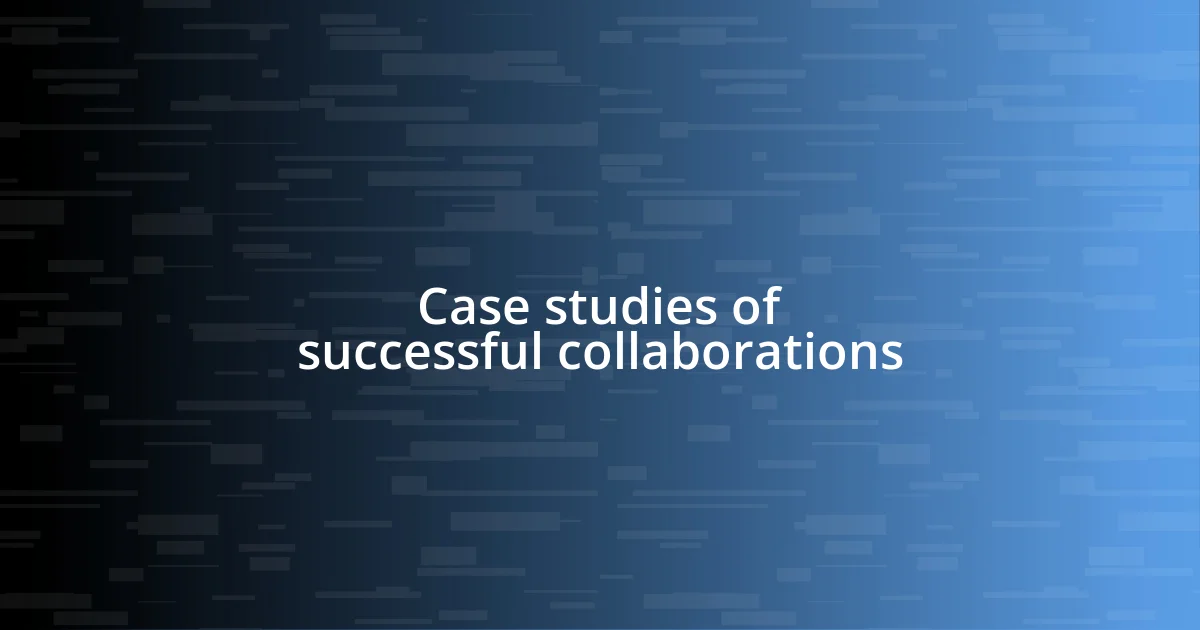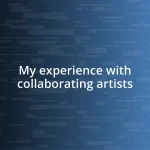Key takeaways:
- Collaboration in theater enriches artistic outcomes by blending diverse talents and fostering a sense of community among cast and crew.
- Effective communication, including regular check-ins and inclusive brainstorming, is essential for enhancing collaboration and ensuring all voices are heard.
- Addressing conflicts constructively and setting clear expectations promotes respect and empowers team members to contribute creatively without fear of backlash.

Importance of collaboration in theater
Collaboration in theater is crucial because it blends diverse talents and perspectives, leading to a richer artistic product. I remember working on a production where the lighting designer was collaborating closely with the director. This exchange sparked creativity that altered scenes in ways I never expected, making the final performance truly unforgettable. Isn’t it fascinating how different artistic lenses can transform a simple idea into something extraordinary?
In my experience, effective collaboration also fosters a sense of community among the cast and crew. I once participated in a workshop where everyone was encouraged to share their thoughts freely. This openness led to a powerful bond, allowing us to support one another not just as colleagues, but as friends. Have you ever witnessed such a bond emerge in a team? It’s these relationships that elevate the art and create a harmonious atmosphere essential for any successful theater production.
Furthermore, collaboration cultivates problem-solving skills and adaptability. I recall a moment during rehearsals when unexpected challenges arose; a lead actor was ill right before opening night. The entire team rallied together, adapting quickly and seamlessly. Reflecting on those moments, I realize that it’s not just about putting on a show—it’s about learning to navigate unpredictability as a united front. Doesn’t that shared experience create a profound sense of achievement?

Roles of collaboration in production
Collaboration in theater production operates like a finely tuned machine, where each role plays a vital part in creating a seamless performance. I recall a striking moment during a musical where the choreographer and the music director worked hand-in-hand. Their back-and-forth conversations not only refined the dancers’ movements but also infused the music with energy that brought the whole show to life. When everyone aligns their expertise, it’s like magic unfolds on stage.
The roles in production can be distinct yet interdependent, each contributing uniquely to the shared vision. Here’s how various collaborative roles come together:
- Director: Provides creative vision, guiding the overall narrative and aesthetic of the production.
- Actors: Bring characters to life, contributing emotional depth and personal interpretations.
- Set Designers: Create the visual environment, using their expertise to enhance storytelling through space and design.
- Lighting Designers: Manipulate lighting to evoke mood and highlight key moments, working closely with the director.
- Costume Designers: Develop costumes that reflect characters’ identities, working with actors to ensure comfort and functionality.
- Stage Managers: Coordinate between departments, ensuring all elements come together smoothly and on schedule.
When each person truly collaborates, the production not only runs better but often exceeds what any individual could have envisioned. Have you ever experienced the thrill of witnessing a diverse team come together to elevate a performance? It’s those moments that reinforce the power of collaboration in the theater.

Benefits of teamwork in theater
The beauty of teamwork in theater lies in its transformative nature. I’ve had the pleasure of working in productions where every individual’s contribution genuinely enhanced the final result. One time, during a passionate discussion about character motivations, I suggested a slight change in my monologue. This simple tweak sparked a dialogue that led to completely reimagined scenes. It was electrifying to see how one small idea could ripple out and elevate the entire narrative.
Moreover, teamwork cultivates resilience and emotional intelligence among the cast and crew. I remember a time when a fellow actor was struggling with their lines, stress etched across their face. The rest of us rallied around, sharing tips and providing encouragement, fostering a supportive environment that transformed anxiety into confidence. Through these experiences, I learned that when we support one another, we not only build a stronger production but also deepen our connections, making the artistic journey even more enriching.
Ultimately, teamwork paves the way for creative exploration and innovation. In rehearsals, I often found that brainstorming sessions with my fellow actors led to breakthroughs beyond my initial vision. One improvisational exercise resulted in a new relationship dynamic between characters, which added layers of complexity and intrigue. Isn’t it amazing how collaboration in theater allows us to explore uncharted territory together, creating an experience that resonates deeply with audiences?
| Benefit | Description |
|---|---|
| Diverse Perspectives | Bringing together different viewpoints leads to richer storylines and character development. |
| Emotional Support | A supportive environment fosters confidence and resilience among cast and crew members. |
| Innovative Solutions | Collaboration encourages creative risk-taking, often resulting in unexpected and exciting outcomes. |

Effective communication strategies
Effective communication is the cornerstone of successful collaboration in theater. I remember being part of a production where our director held regular check-ins with the cast and crew. These meetings became safe spaces for open dialogue, where even the quietest voices could share thoughts or concerns. The way we all contributed built trust, ensuring everyone felt valued. Have you ever noticed how a simple conversation can spark a solution to a lingering issue?
In my experience, clarity in communication makes a significant difference. One time, during tech week, the lighting designer had a vision that seemed drastically different from what we rehearsed. Rather than simply dictating changes, he invited everyone to share their insights during a brainstorming session. This approach not only refined his ideas but created a collaborative atmosphere that fueled creativity. Don’t you think it’s amazing how inclusivity can enhance a shared vision?
Listening is just as crucial as sharing ideas. I’ve had moments where my input was acknowledged in a way that not only validated my experience but also motivated me to dig deeper into my character. When we truly listen to one another, we foster a sense of unity that enhances performance quality. It’s not just about talking at each other; it’s about connecting. What have you found is the key to truly hearing each other in your own collaborative projects?

Conflict resolution in collaborative settings
In collaborative theater settings, conflicts are inevitable, but how we address them can make or break a production. I once encountered a situation during rehearsals when two actors disagreed on the interpretation of a pivotal scene. Instead of letting tensions escalate, we turned the conflict into a constructive discussion. It’s fascinating how simply bringing all voices to the table can transform potential hostility into an opportunity for growth and deeper understanding.
Resolving conflict often requires vulnerability. One memorable moment involved me taking a step back after realizing my strong opinions were overshadowing others’ contributions. I chose to share my feelings openly, which allowed my fellow cast members to express their frustrations too. What struck me was how this honesty not only diffused the tension but also strengthened our bond as a team. Have you ever found that embracing vulnerability can lead to surprising breakthroughs?
Another important aspect of conflict resolution is setting clear boundaries and expectations from the start. In a previous production, our director established a framework for addressing disagreements, which made us all feel safe in voicing our opinions without fear of backlash. This proactive approach fostered an environment of respect, emphasizing that our individual perspectives were valued. Isn’t it empowering when everyone knows they can contribute to the creative process, and that conflicts can be resolved with respect rather than resentment?

Tools to enhance collaboration

Tools to enhance collaboration
One of the most effective tools I’ve encountered for enhancing collaboration in theater is a shared digital platform, like Google Drive. In a recent production, we stored scripts, design plans, and notes in one accessible location. This not only streamlined our communication but also ensured everyone was on the same page, which is essential when the stakes are high. It’s remarkable how technology can facilitate creativity, isn’t it?
Incorporating visual aids can transform our meetings. I remember using a whiteboard during rehearsals to illustrate staging concepts. Seeing ideas drawn out visually sparked lively discussions among actors and crew alike. Those moments of visual collaboration ignited our imagination and led to solutions we hadn’t initially considered. Have you ever found that seeing your ideas come to life visually can shift your perspective entirely?
Regular feedback sessions are another vital tool for fostering collaboration. During a recent workshop, we implemented “feedback loops,” where cast members could offer constructive critiques in a supportive environment. I found this practice so refreshing; it encouraged vulnerability and honesty while reassuring us that we were all in it together. Isn’t it fantastic how creating opportunities for feedback can deepen relationships and elevate the entire production?

Case studies of successful collaborations
In my experience, one standout case of collaboration was with a community theater group that brought together a diverse ensemble for a modern adaptation of a classic play. Initially, we had different interpretations of key themes, which could have led to chaos. However, by dedicating the first few rehearsals to open discussions and creative brainstorming, we forged a collective vision that resonated with everyone. It was heartwarming to see how those early conversations transformed our differences into a shared artistic goal, resulting in a powerful performance.
Another remarkable example was when I collaborated with a choreographer who specialized in integrating movement into storytelling. At first, I was hesitant, worried that my acting might be overshadowed. But as we worked together, I found that the choreography enhanced my character’s emotional arc instead of detracting from it. Embracing this synergy opened my eyes to how blending disciplines can lead to richer narratives. Have you ever felt intimidated by collaboration only to discover that it unlocks new dimensions in your work?
In a professional setting, I recall a musical production where the composer and director had a sincere disagreement over a song’s placement. Instead of competing agendas, they invited the entire team to weigh in. This inclusion not only resolved the conflict but also led to a heartwarming moment when the cast collaboratively played around with the song, resulting in an entirely new arrangement that electrified the audience. Doesn’t it feel invigorating when everyone contributes, sparking solutions that might never have been conceived in isolation?














